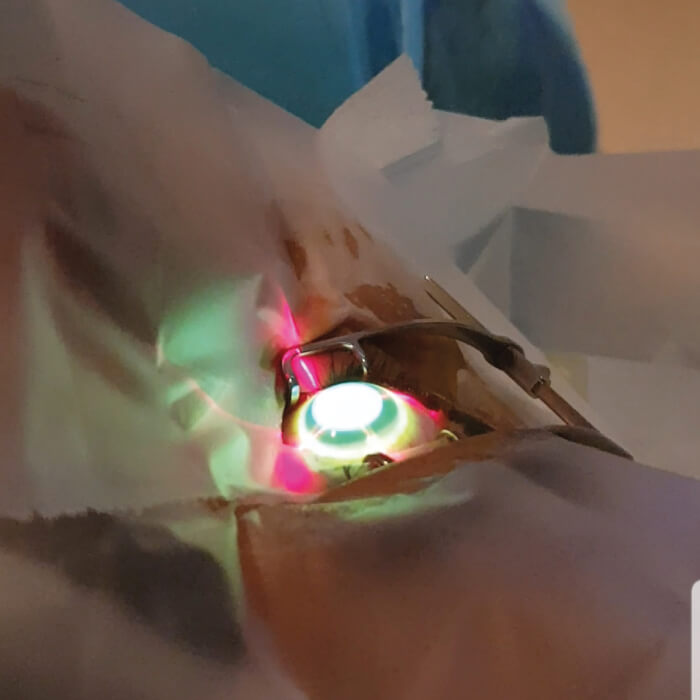
Simultaneous accelerated CXL with LASIK (LASIK Xtra or LASIK Plus) is a procedure that I offer to patients who are suitable candidates for LASIK and have high myopia (>-8D) or hyperopia. It is important for me to note that, in my clinic, it is performed in normal eyes – not those with unusual topography or patients considered to be at higher risk for ectasia. Some authors have previously proposed that CXL be combined with LASIK in eyes with an Ectasia Risk Score System (ERSS, based on Randleman criteria) score of 2 or 3 only (1).
The primary goal of simultaneous CXL at the time of LASIK is to prevent post- LASIK ectasia. By forming new covalent bonds among stromal collagen fibers, cross-linking increases the rigidity of the corneal collagen and its resistance to deformation. Studies have shown that cross-linking at the time of refractive surgery could also improve the stability of the refractive outcome over time and reduce regression (2, 3, 4). This is an important benefit for hyperopes and high myopes, who are more prone to regression.
John Kanellopoulos, who popularized the Athens protocol for transepithelial topo-guided PRK with same-day CXL, has reported on long-term safety of LASIK with CXL in 43 highly myopic eyes that were treated with compounded riboflavin 0.1 percent (Leiter’s), the Priavision UV light source (10mW/cm2 for 3 minutes), IntraLase femtosecond laser (J&J), and the WaveLight excimer laser (Alcon) (5). Aslanides and Mukherjee have also found favorable results in a small series of hyperopes with follow-up of up to 4 years (6). The hyperopes were treated with a Moria microkeratome, Amaris laser (Schwind), and the IROC UV-X1000 device (3mW/cm2 for 30 minutes).
I am currently using the iFS (J&J) and WaveLight (Alcon) lasers and the Avedro KXL system with the VibeX Xtra riboflavin formulation (riboflavin 0.25 percent). Compared with a therapeutic CXL procedure, this prophylactic procedure involves a shorter riboflavin soak time and shorter duration of UVA irradiation, resulting in a lower total UVA energy delivered to the cornea.
Cross-linking is performed immediately after the LASIK procedure. The riboflavin solution is applied to the stromal bed for 45 seconds while the flap is open, followed by irrigation of the stromal bed, replacement of the flap and application of the UVA light at 30mW for 46 seconds at 1.4 J. Other surgeons may vary their protocols in terms of the riboflavin concentration, soak time, and/or amount of UVA energy delivered.
I do not make any adjustments to my LASIK nomogram for patients undergoing simultaneous CXL, nor are there any differences in the postoperative regimen compared with a standard LASIK procedure. However, I do follow high myopes and hyperopes annually to check on their long-term outcomes. Lower myopes are typically not followed after three to six months post-op.
In a retrospective study of 50 consecutive highly myopic eyes (-6.63 to -15.50 D manifest spherical equivalent) undergoing LASIK Xtra at the Singapore National Eye Centre, we found that 80 percent of the eyes achieved uncorrected distance visual acuity (UDVA) of 20/20 or better at three months, compared to 66 percent of a matched control group undergoing LASIK only (p=0.115) (7).
Safety and efficacy indices were comparable for the two procedures. Other published studies have demonstrated similar results, with no reduction in the refractive accuracy of the LASIK procedure (2, 6). In 2016, Tomita reported that no case of post-LASIK ectasia has been reported among 673 eyes treated with LASIK Xtra. Due to the size of the study that would need to be performed to prove a reduction in ectasia (due to its rare occurrence), it would be a challenge to demonstrate a statistically valid reduction in ectasia risk. In 2017, Taneri et al reported the first case of post LASIK ectasia occurring at two years follow-up in a patient who underwent LASIK Xtra for hyperopia (8).
In conclusion, LASIK with simultaneous accelerated CXL is effective in stabilizing refractive outcomes in patients at risk for refractive regression. There is not currently adequate data to demonstrate whether LASIK Xtra can prevent iatrogenic keratectasia and there has already been one report of post-LASIK ectasia in a LASIK Xtra patient. Therefore, LASIK Xtra is not indicated in patients who are not otherwise candidates for LASIK. Future studies would be useful in further evaluating the safety and efficacy of these procedures and to optimize UV-A irradiation settings.
References
- V Derhartunian and M Mrochen, “Effectiveness of CXL combined with LASIK”, CRST-Europe, May 2014.
- J Tan et al., “Consecutive laser in situ keratomileusis and accelerated corneal crosslinking in highly myopic patients: Preliminary results”, Eur J Ophthalmol, (2014). PMID: 25588591.
- A Kanellopoulos et al., “Comparison of prophylactic higher fluence corneal cross-linking to control, in myopic LASIK, one year results”, Clin Ophthalmol, 8, 2373-81 (2014). PMID: 25473264.
- M Tomita, “Combined laser in situ keratomileusis and accelerated corneal cross-linking: An update”, Curr Opin Ophthalmol, 27, 4, 304-10 (2016). PMID: 27152484.
- A Kanellopoulos, “Long-term safety and efficacy follow-up of prophylactic higher fluence collagen crosslinking in high myopic laser-assisted in situ keratomileusis”, Clin Ophthalmol, 6, 1125-30 (2011). PMID: 22888210.
- I Aslanides and A Mukherjee, “Adjuvant corneal crosslinking to prevent hyperopic LASIK regression”, Clin Ophthalmol, 7, 637-641 (2013). PMID: 23576861.
- J Low et al., “Simultaneous accelerated corneal crosslinking and laser in situ keratomileusis for the treatment of high myopia in Asian eyes”, Open Ophthalmol J, 12, 143-53 (2018). PMID: 30123379.
- S Taneri et al., “Corneal ectasia after LASIK combined with prophylactic corneal cross-linking”, J Refract Surg, 33, 1, 50-2 (2017). PMID: 28068447.
